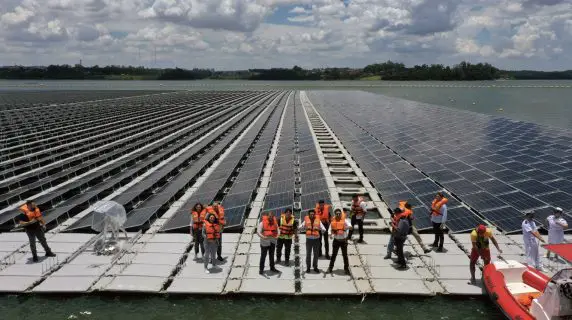A significant milestone in sustainable energy development has reportedly been made in the state of São Paulo. This comes following the inauguration of the first stage of UFF Araucária, the largest floating PV plant project in Brazil. The project is being developed on the Billings reservoir by Empresa Metropolitana de Águas e Energia (EMAE) and KWP Energia.
EMAE is a Brazilian state-owned company linked to the state government of São Paulo. The company is in charge of controlling the volume of water in the Pinheiros River and generating electricity in São Paulo. With its headquarters in São Paulo, KWP Energia on the other hand, is a company that presents innovative solutions in the development and implementation of sustainable projects especially for floating and grounded solar power plants.
The first stage of the UFF Araucária floating PV plant, the cost of which was close to US$ 6.1M, was coordinated by Brazil’s Ministry of Environment, Infrastructure and Logistics. It reportedly features a total of 10, 500 photovoltaic panels strategically installed on high-density polyethylene floats. This approach will ensure efficiency and sustainable energy production at the facility.
UFF Araucária floating PV plant capacity and electricity production
The largest floating PV plant project in Brazil has the capacity to produce up to 10 GWh enough to power approximately 4 thousand homes per year.
The facility will operate in a Distributed Generation (DG) mode. In other words, the UFF Araucária floating PV plant will generate electricity at or near where it will be used. This approach is in line with the modern trends in sustainable energy practices. It promotes energy self-sufficiency and reduces reliance on traditional centralized power generation.

Power generation at the UFF Araucária floating PV plant will commence as soon as Companhia Ambiental do Estado de São Paulo (Cetesb) issues an operating license. Cetesb is a São Paulo state-owned agency responsible for the control, inspection, monitoring and licensing of activities that generate pollution.
The potential of floating solar energy in Brazil
The partial inauguration of the UFF Araucária floating PV plant signifies a major achievement in Brazil’s renewable energy landscape, especially in the area of floating solar photovoltaic technology.
According to research carried out by the Federal University of Rio de Janeiro in 2023, Brazil can generate up to 79.37 GWh of electricity per year, the equivalent of a potential installed capacity of 43.28 GW. This is only if the country utilizes just 1% of each of her 174,526 artificial water bodies such as hydroelectric plants and dams, excluding those on indigenous lands.
The northeastern region of Brazil according to the research has the highest potential. It can produce 10.58 GW or about 24.5% of the total floating PV potential in the country owing to its good solar irradiance. Additionally, this region also has the highest number of artificial water bodies in the country. At number two is the southeastern region with a potential capacity of 10.08 GW (23.3%) while the northern, central and southern regions follow in that order with potential capacities of 8.5 GW (19.7%), 8.2 GW (18.9%), and 5.93 GW (13.7%) respectively.
The results for each state indicated that São Paulo, home to the largest floating PV plant in Brazil has the third-highest potential 3.87 GW. It follows Minas Gerais and Bahia with a potential for 6GW and 4.59GW respectively.
Also Read
Funding Secured for Brazil’s 900Mw Vista Alegre Solar Plant

